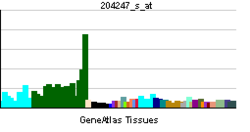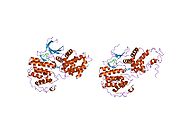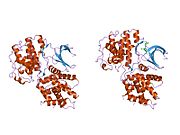- Cyclin-dependent kinase 5
-
Cell division protein kinase 5 is an enzyme that in humans is encoded by the CDK5 gene.[1][1][2][2] The protein encoded by this gene is part of the cyclin-dependent kinase family.
Contents
Physiological Role
Recently Cdk5 has emerged as an essential kinase in sensory pathways. Recent reports of Pareek et al. from NIH suggest its necessity in pain signaling. CDK5 is required for proper development of the brain and to be activated, CDK5 must associate with CDK5R1 or CDK5R2.[3][4] Unlike other cyclin dependent kinases, CDK5 does not also require phosphorylation on the T loop so that binding with the activator is sufficient to activate the kinase.[5]
Cdk5 is involved in the processes of neuronal maturation[6] and migration, phosphorylating the key intracellular adaptor of the reelin signaling chain.[7]
Experiments performed on mice lacking p35, a necessary activator of cdk5 in early brain development, showed that the normal layering of neurons was reversed in the cortex. This disrupted lamination again implicated cdk5 in neuronal migration and plasticity.[8]
Cdk5 is also involved in the regulation of synaptic vesicle exocytosis via phosphorylation of munc-18.[9]
Role in Disease
Dysregulation of this enzyme has been implicated in several neurodegenerative diseases[10] including Alzheimer's.[11]
It is involved in invasive cancers, apparently by reducing the activity of the actin regulatory protein caldesmon.[12]
History
CDK5 was originally named NCLK for Neuronal CDC2-Like Kinase due to its similar phosphorylation motif. CDK5 in combination with an activator was also referred to as Tau Protein Kinase II.[13]
Interactive pathway map
Click on genes, proteins and metabolites below to link to respective articles. [14]
Nicotine Activity on Dopaminergic Neurons edit
Interactions
Cyclin-dependent kinase 5 has been shown to interact with LMTK2,[15] NDEL1,[16] CDK5R1,[5][17] Nestin[18] and PAK1.[19]
References
- ^ a b Demetrick DJ, Zhang H, Beach DH (Feb 1994). "Chromosomal mapping of human CDK2, CDK4, and CDK5 cell cycle kinase genes". Cytogenet Cell Genet 66 (1): 72–4. doi:10.1159/000133669. PMID 8275715.
- ^ a b Meyerson M, Enders GH, Wu CL, Su LK, Gorka C, Nelson C, Harlow E, Tsai LH (Aug 1992). "A family of human cdc2-related protein kinases". EMBO J 11 (8): 2909–17. PMC 556772. PMID 1639063. http://www.pubmedcentral.nih.gov/articlerender.fcgi?tool=pmcentrez&artid=556772.
- ^ Patrick GN, Zukerberg L, Nikolic M, de la Monte S, Dikkes P, Tsai LH (1999). "Conversion of p35 to p25 deregulates Cdk5 activity and promotes neurodegeneration". Nature 402 (6762): 615–22. doi:10.1038/45159. PMID 10604467.
- ^ Paglini G, Cáceres A (2001). "The role of the Cdk5--p35 kinase in neuronal development". Eur. J. Biochem. 268 (6): 1528–33. doi:10.1046/j.1432-1327.2001.02023.x. PMID 11248669.
- ^ a b Tarricone C, Dhavan R, Peng J, Areces LB, Tsai LH, Musacchio A (September 2001). "Structure and regulation of the CDK5-p25(nck5a) complex". Mol. Cell 8 (3): 657–69. doi:10.1016/S1097-2765(01)00343-4. PMID 11583627. http://linkinghub.elsevier.com/retrieve/pii/S1097-2765(01)00343-4.
- ^ Jessberger S, Aigner S, Clemenson GD, et al. (November 2008). Danzer, Steve. ed. "Cdk5 Regulates Accurate Maturation of Newborn Granule Cells in the Adult Hippocampus". PLoS Biol. 6 (11): e272. doi:10.1371/journal.pbio.0060272. PMC 2581629. PMID 18998770. http://www.pubmedcentral.nih.gov/articlerender.fcgi?tool=pmcentrez&artid=2581629.
- ^ Ohshima T, Suzuki H, Morimura T, Ogawa M, Mikoshiba K (April 2007). "Modulation of Reelin signaling by Cyclin-dependent kinase 5". Brain Res. 1140: 84–95. doi:10.1016/j.brainres.2006.01.121. PMID 16529723. http://linkinghub.elsevier.com/retrieve/pii/S0006-8993(06)00373-8.
- ^ Rakic S, Yanagawa Y, Obata K, Faux C, Parnavelas J, Nikolic M (November 2008). "Cortical Interneurons Require p35/Cdk5 for their Migration and Laminar Organization". Cerebral Cortex 19 (8): 1857–69. doi:10.1093/cercor/bhn213. PMC 2705696. PMID 19037081. http://www.pubmedcentral.nih.gov/articlerender.fcgi?tool=pmcentrez&artid=2705696.
- ^ Fletcher AI, Shuang R, Giovannucci DR, Zhang L, Bittner MA, Stuenkel EL (February 1999). "Regulation of exocytosis by cyclin-dependent kinase 5 via phosphorylation of Munc18". J Biol Chem 274 (7): 4027–35. doi:10.1074/jbc.274.7.4027. PMID 9933594.
- ^ Dhavan R, Tsai LH (2001). "A decade of CDK5". Nat. Rev. Mol. Cell Biol. 2 (10): 749–59. doi:10.1038/35096019. PMID 11584302.
- ^ Monaco EA (2004). "Recent evidence regarding a role for Cdk5 dysregulation in Alzheimer's disease". Curr Alzheimer Res 1 (1): 33–8. doi:10.2174/1567205043480519. PMID 15975083. http://www.ingentaconnect.com/content/ben/car/2004/00000001/00000001/art00005.
- ^ Quintavalle, M.; Elia, L.; Price, J. H.; Heynen-Genel, S.; Courtneidge, S. A. (2011). "A Cell-Based High-Content Screening Assay Reveals Activators and Inhibitors of Cancer Cell Invasion". Science Signaling 4 (183): ra49. doi:10.1126/scisignal.2002032. PMID 21791703. http://stke.sciencemag.org/cgi/content/abstract/sigtrans;4/183/ra49.
- ^ Kobayashi S, Ishiguro K, Omori A, Takamatsu M, Arioka M, Imahori K, Uchida T. (1993). "A cdc2-related kinase PSSALRE/cdk5 is homologous with the 30 kDa subunit of tau protein kinase II, a proline-directed protein kinase associated with microtubule". FEBS Letters 335 (2): 171–175. doi:10.1016/0014-5793(93)80723-8. PMID 8253190.
- ^ The interactive pathway map can be edited at WikiPathways: "NicotineDopaminergic_WP1602". http://www.wikipathways.org/index.php/Pathway:WP1602.
- ^ Kesavapany, Sashi; Lau Kwok-Fai, Ackerley Steven, Banner Steven J, Shemilt Stephen J A, Cooper Jonathan D, Leigh P Nigel, Shaw Christopher E, McLoughlin Declan M, Miller Christopher C J (Jun. 2003). "Identification of a novel, membrane-associated neuronal kinase, cyclin-dependent kinase 5/p35-regulated kinase". J. Neurosci. (United States) 23 (12): 4975–83. PMID 12832520.
- ^ Niethammer, M; Smith D S, Ayala R, Peng J, Ko J, Lee M S, Morabito M, Tsai L H (Dec. 2000). "NUDEL is a novel Cdk5 substrate that associates with LIS1 and cytoplasmic dynein". Neuron (United States) 28 (3): 697–711. doi:10.1016/S0896-6273(00)00147-1. ISSN 0896-6273. PMID 11163260.
- ^ Chen, F; Studzinski G P (Jun. 2001). "Expression of the neuronal cyclin-dependent kinase 5 activator p35Nck5a in human monocytic cells is associated with differentiation". Blood (United States) 97 (12): 3763–7. doi:10.1182/blood.V97.12.3763. ISSN 0006-4971. PMID 11389014.
- ^ Sahlgren, Cecilia M; Mikhailov Andrey, Vaittinen Samuli, Pallari Hanna-Mari, Kalimo Hannu, Pant Harish C, Eriksson John E (Jul. 2003). "Cdk5 Regulates the Organization of Nestin and Its Association with p35". Mol. Cell. Biol. (United States) 23 (14): 5090–106. doi:10.1128/MCB.23.14.5090-5106.2003. ISSN 0270-7306. PMC 162223. PMID 12832492. http://www.pubmedcentral.nih.gov/articlerender.fcgi?tool=pmcentrez&artid=162223.
- ^ Rashid, T; Banerjee M, Nikolic M (Dec. 2001). "Phosphorylation of Pak1 by the p35/Cdk5 kinase affects neuronal morphology". J. Biol. Chem. (United States) 276 (52): 49043–52. doi:10.1074/jbc.M105599200. ISSN 0021-9258. PMID 11604394.
Further reading
- Morishima-Kawashima M, Hasegawa M, Takio K, et al. (1995). "Hyperphosphorylation of tau in PHF". Neurobiol. Aging 16 (3): 365–71; discussion 371–80. doi:10.1016/0197-4580(95)00027-C. PMID 7566346.
- Peruzzi F, Gordon J, Darbinian N, Amini S (2003). "Tat-induced deregulation of neuronal differentiation and survival by nerve growth factor pathway". J. Neurovirol. 8 Suppl 2 (2): 91–6. doi:10.1080/13550280290167885. PMID 12491158.
Pareek TK, Keller J, Kesavapany S, Agarwal N, Kuner R, Pant HC, Iadarola MJ, Brady RO, Kulkarni AB (2007) Cyclin-dependent kinase 5 modulates nociceptive signaling through direct phosphorylation of transient receptor potential vanilloid 1 1: Proc Natl Acad Sci U S A. 2007 Jan 9;104(2):660-5.
Pareek TK, Keller J, Kesavapany S, Pant HC, Iadarola MJ, Brady RO, Kulkarni AB (2006) Cyclin-dependent kinase 5 activity regulates pain signaling Proc Natl Acad Sci U S A. 2006 Jan 17;103(3):791-6.
PDB gallery 1h4l: STRUCTURE AND REGULATION OF THE CDK5-P25(NCK5A) COMPLEX1ung: STRUCTURAL MECHANISM FOR THE INHIBITION OF CDK5-P25 BY ROSCOVITINE, ALOISINE AND INDIRUBIN.1unh: STRUCTURAL MECHANISM FOR THE INHIBITION OF CDK5-P25 BY ROSCOVITINE, ALOISINE AND INDIRUBIN.1unl: STRUCTURAL MECHANISM FOR THE INHIBITION OF CD5-P25 FROM THE ROSCOVITINE, ALOISINE AND INDIRUBIN.External links
Cell cycle proteins Cyclin CDK CDK inhibitor P53 p63 p73 family Phases and
checkpointsOther cellular phasesB bsyn: dna (repl, cycl, reco, repr) · tscr (fact, tcrg, nucl, rnat, rept, ptts) · tltn (risu, pttl, nexn) · dnab, rnab/runp · stru (domn, 1°, 2°, 3°, 4°) Categories:- Human proteins
- Cell cycle
- Chromosome 7 gene stubs
Wikimedia Foundation. 2010.







